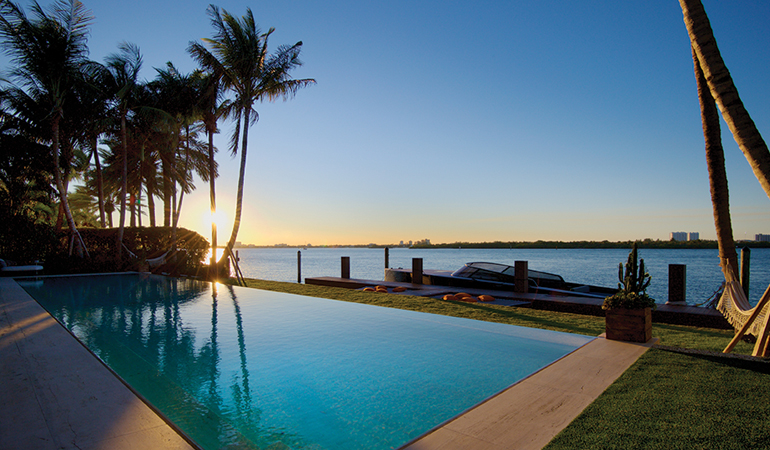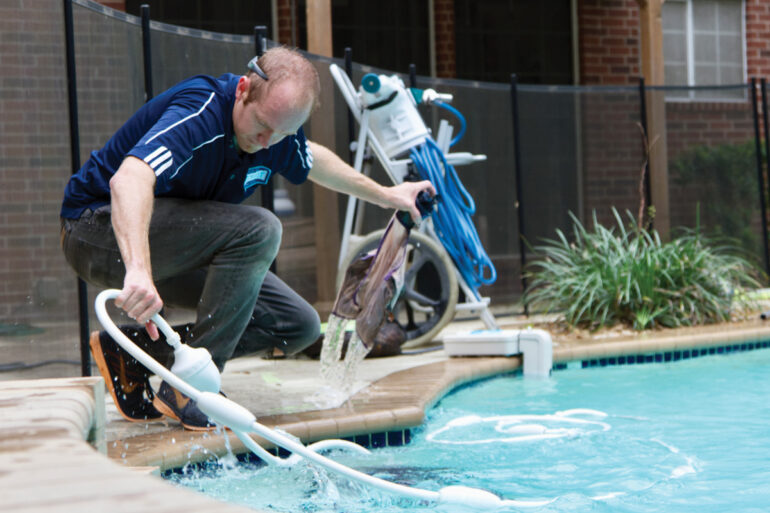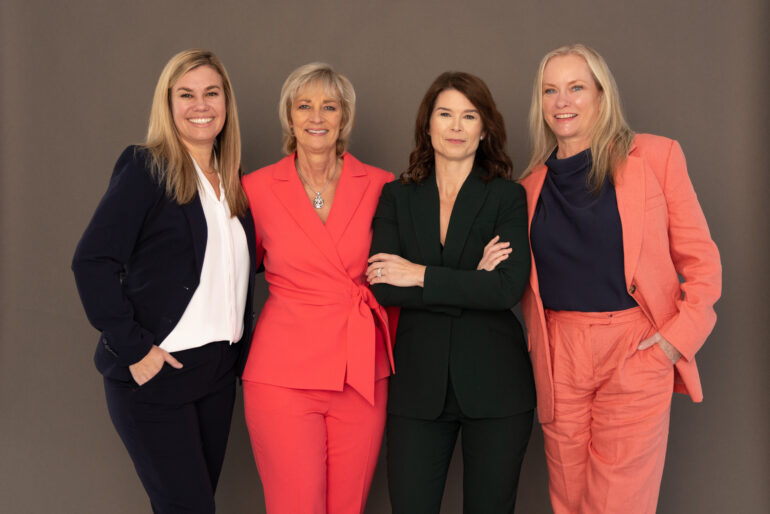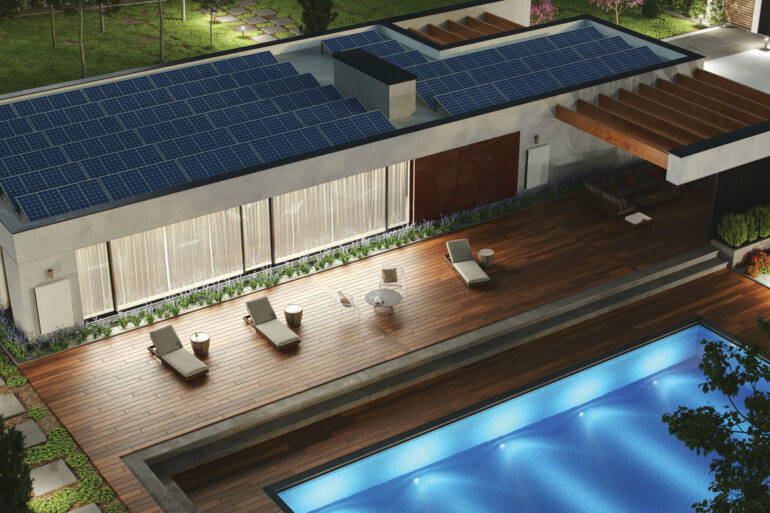By Design

The swankiest section of Miami Beach is home to a $20 million-PLUS mansion that features a perfect rectangle of blue water levitating above the landscaping, apparently unbound by the laws of physics.
The water is contained inside a clear-walled vanishing-edge pool. Linear and seamless, the breathtaking optical illusion is the brainchild of Aquatic Consultants Inc., a licensed commercial pool contractor and design consulting firm with high-end projects around the world.
With the exception of structural work, Aquatic Consultants designed and planned every water-related aspect of the property, including the koi ponds, front-entry water features and rooftop spa.
Brian Van Bower is the CEO of Aquatic Consultants, as well as a co-founder
and ambassador of Genesis, a pool and spa educational entity that provides third-party
accredited education.
• Understand the Client’s Vision •
At Genesis speaking engagements, Van Bower recounts bringing a project like the one in Miami to fruition. “Knowing the goals of the client is first and foremost in our procedure,” Van Bower says. Those clients are often well-heeled homeowners who have are frequently particular and demanding, but “When people have too much money,” Van Bower jokes, “we help them with their problem.”
In this case, the client was The Alexander Group, a developer “trying to make something exciting and unusual,” Van Bower says — in this case, a spec house with no end user.
Van Bower recommended the perimeter-overflow concept after a discussion with the architect, who was just one of several stakeholders.
“These kinds of projects are almost all collaborative efforts,” Van Bower says. “You have to be comfortable working in that environment.”
The group usually includes a general contractor, an interior designer, a lighting expert, the owner’s representative, a landscape architect and a general design architect: Chad Oppenheim of Oppenheim Architecture and Design in Miami.
• Be Honest •
The vanishing-edge pool, which is made of travertine marble, has overflow on all sides, but the three sides with adjacent decking flow into a Lautner knife-edge detail.
When Van Bower suggested a clear vessel, the developer asked how much it would cost. Van Bower sought an estimate from Hammerhead International, a subcontractor that specializes in clear walls. Hammerhead quoted $125,000 to $150,000 for delivery and installation, not including structural support in the shell of the pool.
For Van Bower, being accurate and open about options and pricing is one of the most critical phases of the entire project.
“This way you can determine if you’re going to move forward or if you’re just spinning your wheels,” Van Bower says. “I don’t want to waste time. I want a client to know when there’s a $150,000 add-on.” In selling clients pricey all-tile pools, for example, Van Bower touts their longevity, durability and sheer beauty.
“The way you get people to do things that other people would consider out of the norm is to make it seem normal, and talk about the costs and the benefits,” he says. “I make sure they understand the pros, the cons and the costs. This way you know you’re dealing in reality and not dreams.”
• Obsess Over Details •
Aquatic Consultants has its own design criteria that dictates everything from flow rates to system design. Their pools have large-diameter piping, smaller pumps and bigger filters so they operate more quietly and for less money. They’re almost all on variable-speed pumps.
“We set out to do very detailed plans for something that’s not only aesthetically pleasing, but also something that works well,” Van Bower says.
Overflow on the Miami pool, for example, is on a variable-speed pump so it can overflow at a minimal level when no one is using it, but still function and clean bugs off the surface, “Yet when they have a party with models splashing around and spilling water over the edge, we can put water back in the pool rapidly by turning the pump up,” Van Bower says.
They set the clear panel side one-eighth of an inch lower than the rest of the pool to allow more water to pour over the vanishing edge to avoid unsightly dry spots. The lights are on dimmable circuits through electronic controls with different dimmers for different areas and depths of the pool.
“We try to carry that level of detail all the way through the project,” Van Bower says.
• Know What You Don’t Know •
The 63-foot clear panel is made of fully annealed cell-cast material, a type of specialized acrylic that won’t discolor or crack when exposed to sun and other elements.
The material, which was so heavy it had to be delivered by crane, expands and contracts as the temperature changes. The effect is so dramatic that the length can change by several inches from one day to the next.
“At each end of the vanishing edge, we had to allow a recess that gets filled with a flexible silicone material to allow it to expand and contract,” Van Bower says. “If it were up against concrete at each end, it would just bow in or out, and look terrible.”
All of these variables, however, were predictable, because they relied on the expertise of Hammerhead International during the material-selection phase.
“One thing I would tell anybody who’s attempting to do a project like this, especially if they haven’t done it before, is to not be afraid to ask for help with the things you don’t know everything about,” Van Bower says.
He’s speaking from experience: Twenty-five or 30 years ago, Van Bower did his first clear-panel job with regular acrylic, which quickly turned yellow and brittle before drying out and cracking.
“The next time I did it, I went to somebody who knew what they were doing and got the right material,” he says. “You go to the people who know. If we’re working on a big horsepower pump with an automated control system for variable speed to run through a Jandy or Pentair control system, we don’t sit around saying, ‘I think this will work.’ It has to work. We call the manufacturer and say, ‘I need your top control guy.’ That’s the only way to do it right.”
• Communicate •
Because major projects like the Miami pool have multiple stakeholders, work done by everyone from the general contractor to the landscape architect reflects back on the designer.
“We try to work with all the people who relate to what we’re designing,” Van Bower says. “We like to know the plan for the landscape design. We want to know what they’re putting in there, so it’s not something they think looks pretty but ends up messing up the pool, like bamboo. We love the way bamboo looks, but if you put it anywhere near a pool, it drops debris every day, all day. It would look like hell and they’d blame the pool designer before they’d blame the landscape designer.”
The key is communication, shared plans and group emails.
Communication with the client is especially critical. Wealthy clients, specifically celebrities, tend to guard their privacy closely and often send representatives to discussions and meetings in their place. “We prefer to have direct contact with the end user,” Van Bower says.
Third parties cause delays and increase the likelihood that information will be relayed incorrectly, or that the designer will be blamed for decisions a representative made.
“I’d rather sit with a client and say, ‘Yes, a perimeter overflow pool inside your house is doable, but it’s possible that you’re going to hear the water running because you’re moving 150 gallons of water a minute through a megaphone-shaped gutter, and sound is magnified inside the house,’ ” Van Bower says. “Then they can decide for themselves.”
The pool at the Miami mansion started with a discussion about a client’s vision of building “something that jumps out,” Van Bower says. Through collaboration with multiple specialists, Van Bower’s team designed workable plans that brought that vision to life.













